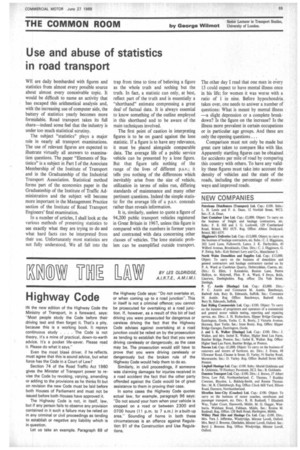Use and abuse of statistics in road transport
Page 71

If you've noticed an error in this article please click here to report it so we can fix it.
WE are daily bombarded with figures and statistics from almost every possible source about almost every conceivable topic. It would be difficult to name an activity that has escaped this arithmetical analysis and, with the increasing use of computer aids, the battery of statistics yearly becomes more formidable. Road transport takes its full share—indeed some feel that the industry is under too much statistical scrutiny.
The subject "statistics" plays a major role in nearly all transport examinations. The use of relevant figures are expected to illustrate virtually all answers to examination questions. The paper "Elements of Statistics" is a subject in Part I of the Associate Membership of the Institute of Transport and in the Graduateship of the Industrial Transport Association. Statistical method forms part of the economics paper in the Graduateship of the Institute of Traffic Administration and the subject will become more important in the Management Practice section of the Institute of Road Transport Engineers' final examination.
In a number of articles, I shall look at the various methods of presenting statistics to see exactly what they are trying to do and what hard facts can be interpreted from their use. Unfortunately most statistics are not fully understood. We all fall into the trap from time to time of believing a figure as the whole truth and nothing but the truth. In fact, a statistic can only, at best, reflect part of the truth and is essentially a "shorthand" estimate compressing a great deal of factual data. It is always essential to know something of the outline employed in this shorthand and to be aware of the main techniques involved.
The first point of caution in interpreting figures is to be on guard against the lone statistic. If a figure is to have any relevance, it must be placed alongside comparable data. The average life of a public service vehicle can be presented by a lone figure. But that figure tells nothing of the range of the lives of different p.s.v.; it tells you nothing of the differences which inevitably arise from the size of vehicle, utilization in terms of miles run, differing standards of maintenance and many other pertinent questions. Indeed the simple statistic for the average life of a p.s.v. conceals rather than reveals information.
It is, similarly, useless to quote a figure of 94,200 public transport vehicles registered in Great Britain in 1967, unless this figure is compared with the numbers in former years and contrasted with data concerning other classes of vehicles. The lone statistic problem can be exemplified outside transport.
The other day I read that one man in every 13 could expect to have mental illness once in his life; for women it was worse with a ratio of 1 in nine. Before hypochondria takes over, one needs to answer a number of questions: What is meant by mental illness —a slight depression or a complete breakdown? Is the figure on the increase? Is the illness more prevalent in certain occupations or in particular age groups. And these are only the Opening questions ..
Comparison must not only be made but great care taken to compare like with like. Apparently startling figures can be obtained for accidents per mile of road by comparing this country with others. To have any validity these figures must take into account the density of vehicles and the state of the roads, including the percentage of motorways and improved roads.


















































































































